Affiliate disclosure: This post may contain affiliate links. Please see our Privacy Policy.
Just about everyone knows what ginger looks like and that it’s a tropical plant. Before modern international trade, fresh ginger was a real treat.
Early colonists in the US found a tasty substitute that that indigenous tribes had been using for centuries. There are two species, Asarum canadense in the East and Asarum caudatum in the West. Either way, it’s commonly known as wild ginger.

Wild ginger is a low-growing, shade-loving perennial with heart-shaped leaves. Landscapers use it as a ground cover under dense shade, and it grows wild in woodland regions across the country.
This patch below is along the side of a hiking trail in Central Vermont.
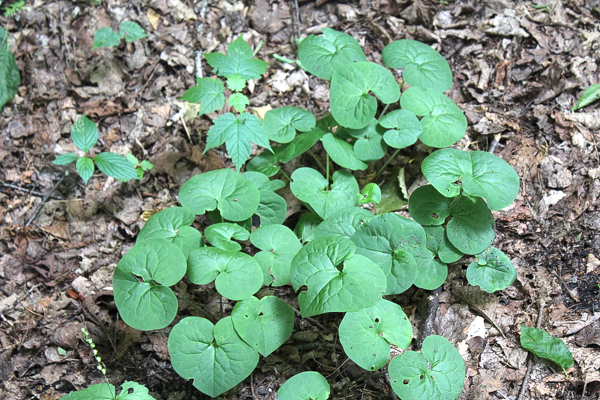
The leaves are heart-shaped, which helps with identification. If you’ve never seen wild ginger, it can be confused with coltsfoot leaves.
When I was initially looking for it, I stopped and inspected just about every patch of coltsfoot along the trail, but that was only because I was so desperate to find it.
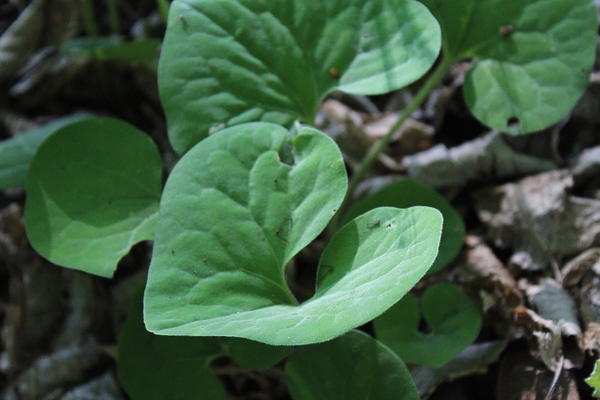
The plants are low-growing, and the leaves are very vaguely similar, but coltsfoot leaves are in no way heart-shaped.
The second giveaway is the flowers. They’re not visible because the plant sends them out under the leaf litter. Pull the leaves back a bit and look for a few of the wild ginger flowers.
The flowers are pollinated by flies and supposedly smell like rotting meat to attract flies trying to find a place to lay their eggs. I couldn’t smell anything in the flowers, I could only smell the ginger scent on their leaves and rhizomes.
Perhaps I found them at the wrong time? Either way, they didn’t smell bad to me.
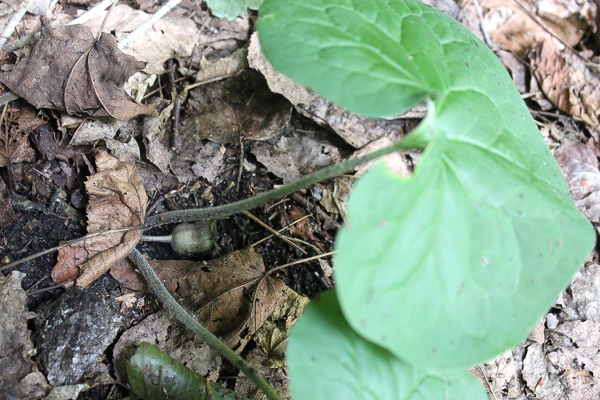
When you pull out a wild ginger flower, it looks a little bit like Trillium.
Some of the flowers have much more elongated “petals.” What looks like petals on the flower are actually sepals, because wild ginger flowers don’t have any true petals.
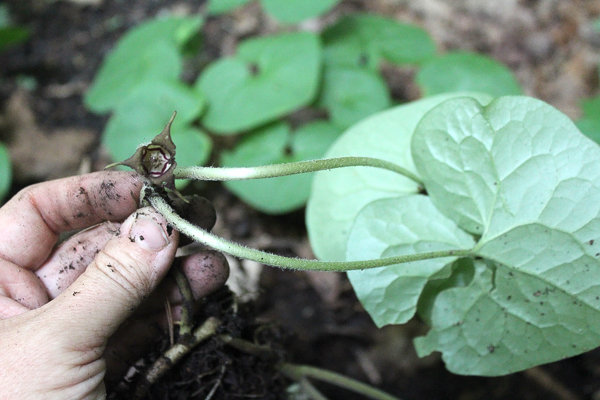
The real prize is the wild ginger rhizome. They’re very small, but they’re tasty and flavorful.
Unfortunately, they’re ever so mildly toxic. Keep in mind, that spinach is also mildly toxic…it’s all about the does.
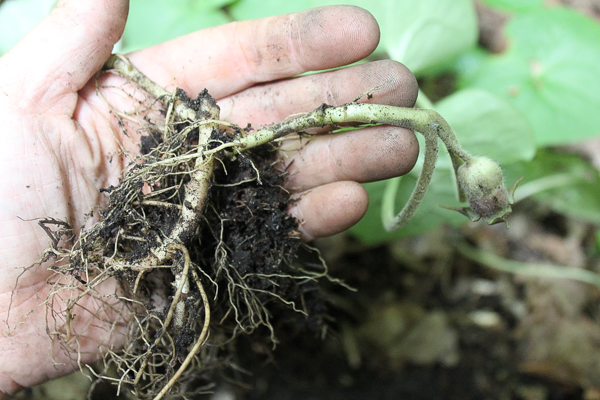
There’s a great discussion on the wild ginger toxicity here, and the take away is that you’d need to eat about 4 1/2 pounds of wild ginger a day for 3-12 months to achieve the toxic dose given to rats.
In reality, even in a big patch, it’s difficult to collect more than a few grams of ginger rhizome. Look how small they are…
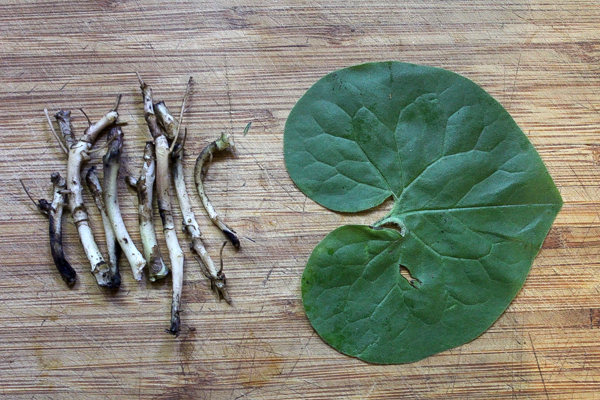
Unlike tropical ginger, much of the flavor is in the stems and leaves rather than the rhizome. Still, those stems and leaves are remarkably light and it’d be a challenge to collect a whole pound even if you decimated the patch.
Beyond the high dose required for toxicity, wild ginger isn’t meant to be eaten whole. It’s most commonly used in tea, and the toxin is not particularly soluble in water. Just avoid eating the whole root, combining it with vinegar or making an alcohol tincture and it should be just fine.
How to Use Wild Ginger
So how do you use wild ginger? It makes a tasty ginger tea that tastes almost exactly like tropical ginger, but without any of the heat. Think of the smell of fresh ginger, but without the spicy burn on your tongue.

Since you’re limited to water extraction, there are only a few other things you can reasonably do with wild ginger besides tea. This recipe for wild ginger ice cream extracts the flavor from the leaves and stems into cream and milk. Since it only uses the leaves, it won’t kill the plant and is a much more sustainable way to forage wild ginger.
Medicinal Uses of Wild Ginger
Though wild ginger is tasty, it’s most often sought out for its medicinal uses. It’s said to “bring on the menses” which is a subtle way of saying that it was used for contraception. Whether it’s used as a preventative, or it’s a straight-up abortifacient is unclear, but use with caution if you’re a female.
Wild ginger is also known as colic root since it’s used to treat colic, upset stomach, indigestion and cramps.
The root contains antibiotic substances, and it can be chopped into a poultice that’s used under plantain leaves to treat open wounds and skin inflammation. One source says that it was used by Meriweather Lewis to treat wounds during his exploration of the Louisiana territory in 1806.
There are accounts that the native Americans sought it out to season meat that died of unknown causes. Since it has broad-spectrum antibiotic properties, this makes a bit of sense.
If you come across a dead animal and you’re hungry, but you don’t know how it died or how long it’s been there…it’s good to use precautions. I’d imagine you’d have to use a lot of wild ginger seasoning to kill pathogens, so I’m not sure how helpful that is.
Wild ginger has also been used to treat heart palpitations, promote sweating to treat fever, as an appetite stimulant and as a general health tonic.
However you use it, use it with caution. It does contain detectable levels of Aristolochic acid which is a known kidney toxin. In very high does, that can be fatal.
You’d need to eat an absurd quantity of wild ginger for fatal results, but be careful using it at all if you have kidney issues.





I have nibbled and eaten leaves and roots of asarum caudatum (W. Oregon) to no harm, and i was going to collect a good number for tea, but did some research first. It seems like there is a lot of anecdotal evidence that even small doses in tea can cause severe vomiting and worse. A person at my workplace was saying that they were confused after hearing it’s fine in small doses when his wife and child got super sick after eating it in tea form. This article points to it not being worth the risk at all. https://naturespoisons.com/2014/09/10/wild-ginger-aristolochic-acid-asarum-aristolochiaceae/
It seems maybe different people are more or less sensitive to the toxin? I am probably less, I’ve eaten decent bites before and never felt an issue. I imagine individual plants vary in concentration too.
That’s interesting information. Thanks for sharing.
Seeing what comes up when clicking the home button on that web site naturespoisons makes it clear that the author/owner, who obviously hates nature, is targeting anything they can label as poison. Even fire ants!!!!! I lived with fire ants for 34 years and the longer I was around them the less I got bit and my immune system responded to almost no reaction to bites the last 10 years. Back to herb…if one uses any herb the wrong way it can be construed as poison to the individual. Too much heat in the body can be as detrimental as too much cold and nobody understands that unless they study and use traditional Chinese medicine for years. Especially if one is on man made drugs, over the counter or illegal, they are all poison way worse than anything growing wild except maybe deathcaps. More and more man made drugs are being created so as to be not compatible with herbs in an effort to make more and more people steered away from natural healing. Permanently. Even wild ginger can be used in similar ways as cultivated ginger when used in traditional Chinese medicine. https://www.meandqi.com/herb-database/wild-ginger Chinese medicine is one of the oldest medicines on the earth and most if not all countries used all natural plant remedies until the united states man made medical system began infiltrating every country. not to mention it is the youngest form of medicine in the world with the most side effects, including death, no cures, and doesn’t utilize anything natural.
Here is a more detailed page on wild ginger use in traditional Chinese medicine that I am more familiar with than the last page I shared https://wuhealing.com/blog/2023/7/11/learn-about-chinese-herbs-xi-xin-asarum-wild-ginger-
Could it be used in Kombucaha?
I don’t see why not.
Awesome! Thanks!
You’re very welcome.
Great article on wild ginger! I find this all the time. I’ve always been curious if it can be used chopped up into stir frys (as long as I’m not using 4.5 pounds of it. lol). Have you ever used it as a seasoning in food (similar to how one might use tropical ginger root)?
I haven’t ever used it that way. Most of the flavor is in the stems and leaves and it is typically used as a tea.
Thank you for responding!
You’re very welcome.
Be careful eating Asarum species, they contain aristolochic acid that has been documentes to cause urothelial carcinoma.
Please see this article its peer reviewed and we’ll supported
https://www.frontiersin.org/articles/10.3389/fphar.2019.00648/full
Thank you for sharing. There are certainly precautions that need to be considered which was discussed along with a link talking about the possibility of toxicity in wild ginger in the post. The conclusion was that a person would have to eat roughly 4 1/2 pounds of ginger daily for 3 to 12 months in order to achieve a toxic dose. It is highly unlikely that a person would be consuming this much wild ginger.
That is not the conclusion of any peer-reviewed scientific study. How animal models in research react to chemicals is not a direct correlation to how the human body reacts. For example, there are 127 cures for cancer in laboratory mice or or rats. NONE of these treatments are effective in human beings. Cis-platin is the only treatment for humans that originated in a study of laboratory mice.
That said, there is no established amount of how much wild ginger will kill you. What is known is this: wild ginger caused kidney failure in approximately 5% of the people who participated in a study. 40% of the people who ended up with kidney disease also developed cancer of the urethra – including those who received kidney transplants.
The bottom line is that wild ginger comes in several varieties (except Europe – which only has one). They all contain varying amounts of Aristolochic acid, which is the chemical that can kill you. And 5% in a scientific study is statistically alarming. So, stay away from it and eat something in the wild that won’t make you sick or kill you, such as wild strawberries.
Thank you for your newsletter. I’m looking forward to reading them.
You’re welcome!